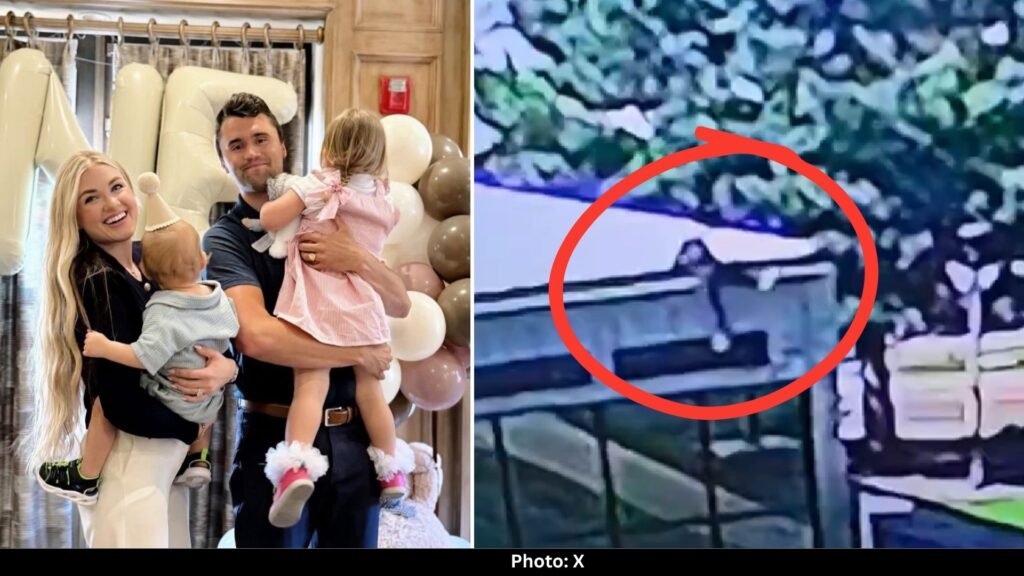Utah authorities released new footage that shed more light on the suspect believed to be behind the killing of conservative activist Charlie Kirk. The video shows a person lying flat on the roof of a campus building, then springing to their feet, running across the roofline, and finally dropping down onto the grass with a backpack slung over their shoulder.
Investigators described the suspect’s outfit as very distinctive: a black t-shirt with an American flag and what looked like an eagle, jeans, Converse sneakers, sunglasses, and a triangle-marked cap. A black backpack rounded out the look.
Despite the sharp description and wide circulation of the images, the authorities have no idea where the suspect is. He could still be hiding in Utah, or he might already be across state lines.
Tracking the Trail
The suspect left behind palm impressions as he clambered down from the roof, and investigators are now working to see if those smudges carry recoverable DNA. Shoe prints on the grass suggest the suspect was indeed wearing Converse sneakers.
Authorities also recovered the weapon used in the attack. It was a Mauser bolt-action rifle, .30-06 caliber, fitted with a long-distance scope. The discovery was made after investigators used the video trail to backtrack the suspect’s movements into a wooded area.
An audio analysis of the shooting indicates Kirk was killed by a single supersonic round. It was clean, precise, and deliberate.
Messages in the Ammunition
Inside the rifle, investigators found three chambered rounds alongside a spent casing. What caught their attention were engravings etched onto the ammunition. Some preliminary interpretations suggested the markings pointed to anti-fascist and transgender-related ideology.
But those interpretations are still under review, and officials have not confirmed a motive. It is one thing to find cryptic symbols, it is another to prove intent.
Witnesses Remember Strange Sightings
One student from Utah Valley recalled seeing a man on or near the roof of the same building twice in the weeks before the shooting. They described the behavior as strange. At one point, a professor even called out to check if the man was alright.
In hindsight, it looks like the suspect might have been scouting the area, rehearsing, or simply trying to blend in until the right moment arrived.
The Investigation So Far
The scale of the investigation is massive. Authorities have received more than 7,000 tips and conducted nearly 200 interviews. The FBI has put a $100,000 reward on the table for any information leading to an arrest.
Utah’s governor has made it clear: once caught, prosecutors will pursue the death penalty. That statement alone tells us how seriously officials are treating the case, and how much political weight the killing already carries.
When Politics Turns Deadly
Kirk’s killing is not just a crime. It is a shockwave running through America’s political bloodstream. He was a polarizing figure, no doubt, but he thrived on open college-campus events where debate was encouraged and disagreements were aired in public.
What this really means is that the act of standing on a stage, microphone in hand, has suddenly become a reminder of how vulnerable public figures are. And if open-air rallies are now seen as soft targets, the very idea of grassroots campaigning could change.
Shrinking Public Spaces
Some lawmakers are already rethinking how they show up to voters. One Republican senator admitted that while he values accessibility, being accessible is starting to look like being vulnerable. The suggestion is simple: fewer outdoor rallies, more controlled indoor events.
It sounds practical, but the cost is high. American politics has long thrived on the town hall, the park gathering, the coffee shop meeting where voters can look a candidate in the eye. Strip that away, and politics risks becoming more distant, more radical, and less human.
A History Written in Bullets
Political violence is not new in the United States. Robert F. Kennedy was gunned down in 1968, just after winning the California primary. Arizona congresswoman Gabrielle Giffords was shot during a constituent meeting outside a grocery store in 2011. House Majority Leader Steve Scalise nearly lost his life at a congressional baseball practice in 2017.
Go further back, and you find Abraham Lincoln killed in a theater, and Martin Luther King Jr. assassinated on a motel balcony. American democracy has always carried the shadow of violence. But each new attack reignites the question: can democracy survive when disagreement is answered with a gun?
A Voice for Open Debate
Those who knew Kirk argue that he wanted politics to be confrontational but civil. He invited skeptics to his events. He welcomed questions, even hostile ones, because he saw value in open confrontation. His critics saw him as provocative, but his allies believe he defended the idea that freedom of speech includes the right to argue without fear of being silenced or worse, shot.
The Frustration Among Lawmakers
Kirk’s death sparked immediate frustration among lawmakers. Some voiced that democracy itself is at stake. They pointed out that even if one disagreed with Kirk’s views, he created spaces where opponents could engage him without fear. That, they argued, should never be considered a threat.
The Security Question
House leadership has already begun internal discussions about boosting security for lawmakers when they leave Capitol Hill. The January 6 attack remains fresh in their minds, when even the halls of Congress were not safe.
But extending full security details to every member of Congress is practically impossible. It would cost billions, and even then, public life cannot be hermetically sealed. A rifle does not need permission to cross a perimeter.
The Impossible Balance
America faces an impossible balance: keep politics open and accessible, or close it off in the name of safety. Both options come with a price. Limit access, and democracy risks becoming elitist and performative. Keep it open, and the risks remain chillingly clear.
What Gets Lost
If politics moves into locked halls and behind security screens, something quintessentially American fades away. Think of the Iowa coffee shops where unknown candidates first cut their teeth. Think of Barack Obama in 2007, standing in school gymnasiums, working the crowd on healthcare. Think of Donald Trump in 2015, standing on chamber of commerce chairs as business leaders tried to get a glimpse of the man who would upend the Republican Party.
These moments cannot be recreated in sterile, secured environments. They rely on closeness, risk, and the raw electricity of unscripted encounters.
The Blame Game
After Kirk’s assassination, political leaders across the aisle called for calm. But within hours, the rhetoric hardened. The president blamed the radical left. Progressive voices accused the president of exploiting the tragedy. Conservatives insisted that years of calling Trump a danger to democracy had fueled assassination attempts.
Each side sees itself as the victim, and each tragedy becomes a weapon for the next round of outrage. The cycle feeds itself, and the reservoir of resentment never runs dry.
Lessons from the Past
The timing of Kirk’s death on the eve of the September 11 anniversary added another layer of reflection. Back in 2001, the nation briefly rediscovered unity in grief and fear. But even then, the solidarity was temporary. The divisions roared back, deeper than before.
Today, that unity feels impossible. America’s enemies are often defined not by foreign powers, but by neighbors across the political aisle. That is a dangerous place for any democracy to be.
What Comes Next
The investigation will continue, the suspect will eventually be found, and the justice system will take its course. But the bigger question lingers: what will America do about the climate that makes political assassination feel thinkable?
Every election cycle, the stakes rise higher, the rhetoric turns harsher, and the lines of civility collapse further. Unless something changes, Kirk’s death will not be the last.
Closing Thought
Democracy requires risk. Standing in a crowd, taking questions, being challenged, it is uncomfortable and sometimes dangerous. But without it, politics turns into performance, disconnected from the people it is meant to serve.
The killing of Charlie Kirk may change how campaigns are run, how lawmakers move, and how rallies are staged. But if America loses the small-town meetings, the open-air debates, and the face-to-face exchanges, it loses a part of itself.
Read More: Charlie Kirk Assassination: America’s Most Wanted Face Revealed, This Photo Could Break the Case




